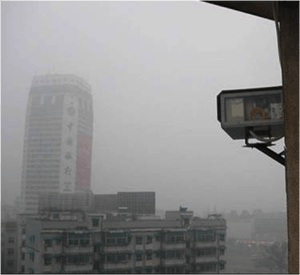FSO and Visibility and Atmospherics FAQs
What is “visibility” – and how does it relate to FSO performance?
The human eye is capable of distinguishing one object from another so long as there is at least a 5% contrast ratio between the two objects. If the contrast ratio is less than that, the viewer cannot discern the difference between light and dark objects.
Contrast ratio is another way of saying that you are seeing only a given percentage of the reflected light – so a contrast ratio of 5% you are seeing 5% of the reflected light from an object through the air. This means that the object is discernable from the background, and hence ‘visible’.
Visibility measurements are quoted in terms of distance. So, for a visibility of 500 meters, an object under 500 meters away is ‘visible’, and one above 500 meters distance is not.

Visibility and Free Space Optics Link Planning
Visibility as a factor planning Free Space Optics (FSO)Informal visibility measurements are performed by humans reporting the visibility of a landmark at a known distance. However, more scientifically, special instruments are used to obtain these measurements, which are used at weather reporting stations to gather accurate statistics. Fortunately for FSO, the aviation industry that is has gathered extensive long-term statistics on visibility, with some 2,700 measurement points and nearly 10 years of data collected at airports worldwide. Though there are limitations in the resolution of this data, nevertheless it is vital for users of FSO equipment.
Visibility is an important decider for users planning deployment of FSO. The infrared wavelengths used in commercial FSO systems propagate quite similarly to the visible wavelength, with additional benefit that penetration improves with wavelength – so infrared ‘goes further’ than visible light – very important.
To correlate this to FSO, here is the reasoning:
A 5% contrast means that 95% of the visible light is being scattered/absorbed by the atmosphere – is attenuated. AND the 5% of visible light coming to you is no more than 13 dB down, or else you would not be able to see the object with your naked eye. So if you can see an object in the fog, it is no more than 13 dB “away” from you.
The photodiodes used in FSO systems typically can “see” much less light than the human eye can detect – often 30 or more dB less (around 1/1,000 of the power). In addition, the ‘improvement’ of infrared over visible light means that FSO can operate at significantly longer distances than visibility might suggest.
Visibility encompasses all major forms of atmospheric attenuation – fog, snow, rain, dust-storms, smog being examples. This ‘all-in-one’ statistic makes sense when worldwide data is available, together with FSO planning tools. Simply plug in the local data, and out comes sensible predictions on link performance versus range.
Though there is no internationally-recognised formula or standards-body for FSO and availability, several FSO vendors have played a leading part in defining parameters, and more useful still, tools to enable users to plan for given countries and cities.
For Further Information
Please Contact Us
You must be logged in to post a comment.